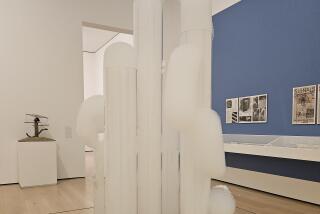Laced with an irreverent spirit
A sleek gallery with pale blue walls and ribbed rubber flooring seems an appropriately modern setting for the artwork of “The Societe Anonyme: Modernism for America” at the UCLA Hammer Museum. But what’s with the paper lace framing some of the paintings?
This gallery, it turns out, replicates the landmark 1920 inaugural exhibition put on by the Societe Anonyme in two rooms of a New York town house. Marcel Duchamp, the exhibition designer (who the year before had put a mustache and goatee on the Mona Lisa), transformed the domestic setting with an industrial sensibility, then added a Dadaist gesture -- a frilly one.
At the Hammer, the paper lace is especially incongruous on such works as Joseph Stella’s invocation of industrial America, “Brooklyn Bridge,” and Vincent van Gogh’s pensive “Adeline Ravoux” -- artists and work usually presented with reverence, not schoolboy humor. At the opening last weekend, some visitors chuckled; others were puzzled.
Founded in 1920 by artists Duchamp, Katherine Dreier and Man Ray, the Societe Anonyme has gotten short shrift in the annals of art history, says Jennifer Gross, lead curator for the show and curator of modern and contemporary art at Yale University Art Gallery, the exhibition organizer. In 1941, Yale became the recipient of the Societe’s collection, and most of the nearly 240 pieces in the current show are drawn from there.
Documentation for the inaugural show was sparse, but a newspaper review from May 1920 by critic Henry McBride described the installation and says of several works, “All these paintings are framed in strips of lace paper.”
In addition, a historical photograph of a Jacques Villon, “In Memoriam,” was found thus embellished, with doilies placed directly on the painting’s frame.
Gross thought it would be especially interesting to replicate that first show, paper lace and all, and the Hammer agreed. (Other venues for the exhibition, which begins a three-year tour, will decide for themselves. At the Hammer the show continues through Aug. 20; see www.hammer.ucla.edu.)
Gross assigned to her assistant Valerie Richardson the task of tracking down doilies, or strip lace, as it’s called by food industry suppliers.
“I thought it would be a fairly simple process,” Richardson says, “but the standard is a 40-inch strip, and we needed something longer for some of the larger paintings.”
She contacted a company that claims to be the nation’s oldest purveyor of paper doilies, Brooklace of West Haven, Conn., where her request fell to John Lesage, vice president of manufacturing. “It sounded like a lot of fun,” Lesage says, “and Yale is in our own backyard. The challenge was to make a continuous roll, so we had to retrofit the machinery for a special run.”
He gives a chuckle: “In the end we made 2 1/2 miles of this stuff!”
Lesage notes that his company was founded in 1875 in Brooklyn, N.Y. -- it used to be called Brooklyn Lace -- and moved to Connecticut in 1992. “The funny thing is, that might have been our strip lace back then,” he says of the 1920 show.
Once the doilies were made, Patricia Garland, senior conservator at the Yale Gallery, enlisted a student hire to punch out errant chads that hadn’t dislodged in manufacturing.
In addition, “We were very concerned with being able to take the material on and off without damaging the frames,” Garland says. She applied a coating of Acryloid B-72, a commonly used resin that is “reversible and seals the surface and protects it” before the paintings left Connecticut. In L.A., she cut the strip lace to fit and affixed it to the frames with double-sided tape.
Had she ever done something like this before? “Never,” she says, laughing. “It’s very unusual. I have a new skill now.”
Duchamp did not write about using the doilies, Gross says, so it’s mostly up to art historians to interpret his choice. But she’s convinced that the artists were “excited about embracing the energetic, joyful and counterintuitive spirit of the Dadaists.”
Russell Ferguson, chief curator at the Hammer, says the Dadaist gesture “reflects interests Duchamp had throughout his career” and that “it also has the effect of deflating any kind of macho pretensions.”
In a catalog essay, Yale professor of art history David Joselit says the exhibition took place when Duchamp was exploring a feminine alter ego, Rrose Selavy -- a play on the French phrase “Eros, c’est la vie,” meaning “Eros, that’s life.”
The artist was photographed by Man Ray in drag as Rrose Selavy, and he signed the occasional work with that name. Joselit also says that Duchamp was close friends with artist Florine Stettheimer, who apparently had a passion for lace and had her lacy bed canopy replicated for her one-person show at Knoedler Gallery in 1916.
“Just at the moment when Duchamp divided into Rrose Selavy,” Joselit writes, “he created an equally hermaphroditic exhibition in which masculinized artworks occupied a feminized salon....
“In lace,” Joselit writes, Duchamp “found a material signifying not only the feminine ‘frames’ of clothing or curtains but an abstract texture that is ‘all frame’ -- a tracery of lines delineating a pattern of gaps.”
At the Hammer, Ferguson says, “People certainly look at the works differently with that lace on them.”
That might have pleased Dreier. In a 1941 letter to Yale President Charles Seymour, she wrote that the art would benefit young students. “This will revitalize them,” she said, “and create an inner moral courage and discipline to be the best in themselves instead of falling into the line of a set pattern of standards.”
More to Read
The biggest entertainment stories
Get our big stories about Hollywood, film, television, music, arts, culture and more right in your inbox as soon as they publish.
You may occasionally receive promotional content from the Los Angeles Times.










